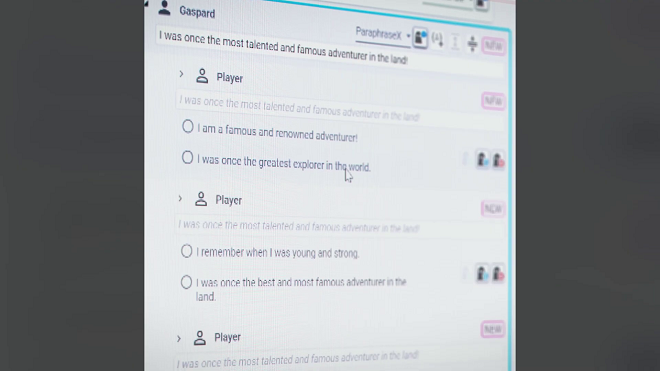Quarantine Control #155: Last of the Rabbit Visitors

In a country with a health care system as pitiful like the United States, we were bound to reach the question of whether COVID-19 vaccines will remain free for everyone or not. It’s bad enough that the system, though the egregious prices of big pharma, charges for other vaccines like those for the flu and the measles. Charging for COVID-19 vaccines is immoral considering we’re still within the pandemic, but there’s no working mechanism within our system to stop manufacturers like Pfizer and Moderna from jacking up prices hardcore for those who can’t afford it.
Geoffrey Barnes
The Last of Us (2023)
Source: HBO Max
Episodes: 9
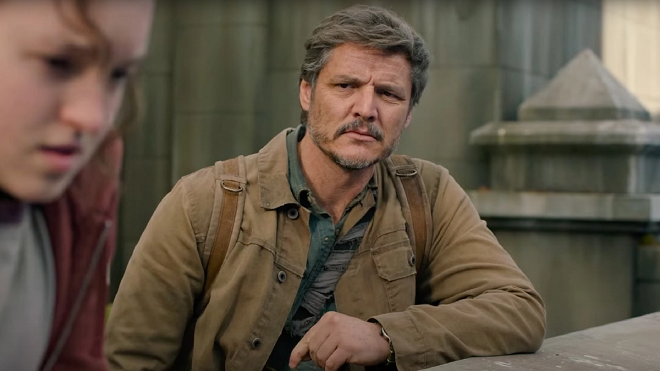
The Last of Us series on HBO was bound to be one of the best examples of a video game adaptation. The Naughty Dog-developed game itself was among the finer cinematic video game experiences when it released in 2013, and few titles have come close to competing for the prize since then. Though games like Quantic Dream’s Heavy Rain (which we streamed) and Beyond: Two Souls are adventure games, a genre tailored more towards cinematic experiences, they made stumbles in terms of their presentation. David Cage, alas, is nowhere near as good of a writer as he thinks he is, but no one can tell him that. TLOU was at least competent when it came to writing and direction, and that all transferred superbly over to the HBO series.
It also helped that a hell of a creative team was assembled for the show, including showrunner Craig Mazin (of superlative HBO series Chernobyl), and HBO itself has high standards for quality and writing. It was always going to be good. It was nonetheless a surprise to see just how good it was.
The TLOU series follows many of the game’s plot beats, with minimal changes for added drama effects (it’s remarkably been nearly a decade since the game released, a period during which we tripped our way through a real pandemic) and because not every video game element can seamlessly carry over to the live-action world.
It opens in 2003, with the initial focus remaining on Joel Miller (Pedro Pascal) and daughter Sarah Miller (Nico Parker), before the state of Texas and the United States by extension plunges into a hell on Earth after the deadly Cordyceps brain infection starts spreading. The heart of TLOU’s drama opens here, as the series quickly shifts the setting to 2023, an alternate present day with the intent on showing just how harsh and dilapidated the show’s world has become. Joel, who’s since moved to Boston, Massachusetts and Tess (Anna Torv) are tasked with escorting Ellie (Bella Ramsey) to the Fireflies’ hospital facility on the west coast by Marlene (Merle Dandridge). Ellie is one of the few people left in the world immune to the virus, and could be key to a vaccine.
It must again be said that the TLOU game was a linear story-driven experience, the story for which was not as difficult to transfer to a live-action show compared to others. But it’s still worth praising the showrunners and producers for the excellent acting and direction they provided, which nails the human drama and worldbuilding enough to make it one of the best post-apocalyptic shows in recent years. The same applies to the writing, with new lines created for new scenes and several being rewritten to fit the skills of the actors and flow better in general. The producers knew which scenes from the game were worth keeping, which scenarios and plot points were worth expounding upon, and those that were worth excising. All of these decisions together helped the series progress at a brisk pace. Even if the show’s story didn’t take as long to reach its destination as the game, I didn’t come away feeling like anything notable was cut by the end. That’s what matters most.
The actors also did a hell of a job all around. Anyone who knew Pedro Pascal from more than The Mandalorian (another show in which he escorts a younger child who isn’t his own) knew he could hold his own. But this show feels like the moment in which Bella Ramsey fully established herself as talented. I saw no shortage of concerns about whether she was a good casting choice for Ellie prior to the show airing, from people who simply couldn’t wait and see what she would do with it. She did a great job, and excellently hid her British accent. The aforementioned Nico Parker and Nick Offerman as Bill were also excellent, despite how both of them weren’t around for long.
(I was ready to complain about Annie Wersching not reprising her role as Tess from the game following the second episode, despite Anna Torv being great in the role. Merle Dandridge reprised the role of Marlene from the game, after all. I should have guessed that she was having health issues, with Wersching losing her battle with cancer during the show’s run. It’s a huge loss for anyone who remembers her role in the game, and in other roles like Renee Walker in 24.)
I’m astounded that I didn’t feel that anything essential was missing from the show by the end, a complaint I expected to lodge at it after the finale if it wasn’t hours long. Indeed, much of the video game-style exploration wouldn’t have carried over well to a show. The only key problem I had involved the sheer lack of infected. The TLOU show changing the way in which people contract the Cordyceps brain infection is one thing, but that didn’t change too much of the drama. I understood the need to distinguish this from the several other zombie shows, but the human enemies received considerably more focus here compared to the game, to the point that it was easy to forget the infected even existed for a time. As if to get ahead of this concern, Mazin and series creator Neil Druckmann wasted no time confirming that the second season will have more. As it stands, the series could have used one more episode with a heavier focus on the characters encountering them.
That issue was nowhere near enough to bring down one of the best transitions from a video game to a live-action work. TLOU is hardly the first good video game adaptation, but there isn’t a more convenient recent guide showing how one should be made. The key is to make necessary changes, but nonetheless remain faithful to and respect the source material. The trend should be maintained for the adaptation of The Last of Us Part II, expected to be split over two seasons thanks to the game itself being longer. In the meantime, expect to see plenty more video game adaptations green lit, like a Ghost of Tsushima film. Well, if they’re not already in the works, like Fallout, Twisted Metal, and Borderlands.
Angela Moseley
On the gaming side of my life, my foray into Monster Hunter Rise continues when I’m not streaming Shin Megami Tensei: Devil Summoner 2: Raidou Kuzunoha vs. King Abaddon. I’m finally out of low rank in Rise, and now my grind in high rank can begin. Oh, and I watched some anime nearly as old as me last week.
Baoh: The Visitor (1989)
Source: YouTube, The Internet Archive
Episodes: 1 OVA
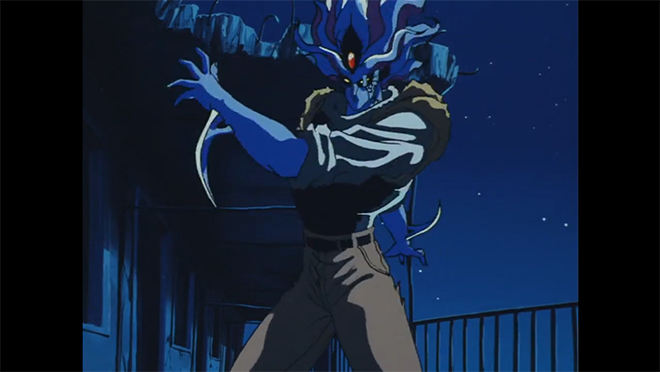
I’d never heard of Baoh before I listened to Retronauts 519: JoJo’s Bizarre Adventure, Chapter 2. The mention of this OVA was a quick reference to the character’s appearance in JoJo’s Bizarre Adventure: All Star Battle. The anime short itself was described as a cross between JoJo’s Bizarre Adventure and Guyver: The Bioboosted Armor. I liked both, and decided I needed to see this OVA. Better yet, someone uploaded it to YouTube nearly a decade ago, and it’s still readily available. After my initial viewing of the subtitled version on YouTube, I discovered the English dubbed version, and a slightly different English subtitled version on the Internet Archive. Which works because Baoh is long out of print.
Baoh: The Visitor was originally penned by Hirohiko Araki for Shonen Jump from 1984 to 1985. Yes, this is Araki’s first work before he would pen Gorgeous Irene in 1987, and then the first part of JoJo’s Bizarre Adventure in the same year. Baoh was fairly short, coming in at just two manga volumes. In 1989 the story received an anime OVA adaptation from Pierrot (best known for Bleach and Naruto). The OVA was brought to North America on laser disc in 1995 and DVD in 2002 by AnimEigo. At the time it was not well-received, at least outside of Japan. Not that it would matter, as Araki had found massive success with JoJo’s Bizarre Adventure. Baoh himself would not be forgotten, as I mentioned above he did find his way into the All Star Battle game.
Sumire is a 9-year-old girl with special psychic abilities, including premonition. She’s escaped from her containment on a transport train and agents of the Doress organization are in pursuit. She runs through a variety of train cars until she reaches one car holding a super-secret specimen only known as “Baoh.” Dr. Kasuminome is in charge of the project and orders the girl to be subdued. The doctor’s assistant, Sophine grabs the girl, but before she can be taken away, the pressurized tank holding Baoh begins to leak. The scientist and his assists rush to keep the lid closed, but in the chaos, Sumire escapes to another car and uncouples it.
Meanwhile, Baoh, a young adult escapes his confinement and kills anyone who tries to stop him. He escapes from the train by grabbing high voltage wires, which don’t kill him. As the train carrying Dr. Kasuminome and Sophine take them further away from Baoh, Sumire’s uncoupled car stops near him. A few days later, Sumire and Baoh, whose actual name is Ikuro Hashizawa are on the run as agents of Doress attempt to track them down and kill them. In the carnage Ikuro discovers that Doress experimented on him and granted him amazing abilities that allow him to become a literal bioweapon.
At just under an hour, Baoh is a breeze to get through. The story is interesting, but ultimately unremarkable. It is fascinating to see the buds of ideas Araki had that would eventually take root in JoJo’s Bizarre Adventure. Namely, Baoh’s arm blades (which are highly reminiscent of Guyver’s) and how the concept would be used again for the villain Kars, in part 2 of JoJo’s, aka Battle Tendency. Also, Baoh’s look and some of his abilities would later be re-imagined as stand abilities in later parts of JoJo’s. I must note that this OVA immediately starts off with extreme violence towards dogs, which again is familiar territory for Araki’s works. (In short, don’t be a dog in any of this manga author’s works.)
This short is a well-animated, albeit weird, spectacle. It is a mixture of fun and slightly horrifying as Ikuro rampages after transforming into Baoh. You almost feel bad for the humans he tears into. Almost. Even in its violence it has occasional touches of dark humor. (I’m not sure all of it is intentionally funny.) I can’t say there are any meaningful takeaways as this story is quite shallow. The bond between Sumire and Ikuro is touching, as she’s highly competent and intelligent, and he has an innocent air. It’s just a pity that nearly half of Sumire’s time in this OVA is reduced to being a damsel in distress.
As for the merits of this animation sans the JoJo’s comparisons, again it is an entertaining watch. The plot is fairly simple, Ikuro and Sumire are on the run, Doress messes with them, and comes to regret their experiment. All in all, I can recommend Baoh: The Visitor because it’s only an hour long. It’s neat to see Araki’s earliest work and how his abilities as storyteller have evolved throughout the decades.
Joseph Daniels
Last week on Quarantine Control, I very briefly mentioned films on Disney+ featuring rabbits, and admittedly, the write-ups were anemic. In my defense, they were all famous films from the Disney Animated Canon, so there wasn’t a lot I could say that you haven’t already heard, not without going in depth. If ever I decide to do a retrospective project revolving around these films, I will go into as much detail as I am capable of, but until then, there’s not a lot to say. They’re Disney films and a majority of people who read our column will have likely heard of them, even those who haven’t seen them.
This week, I’m focusing on Netflix. In the past couple years alone, several films and television shows with rabbits central to their story were released. I’ve covered the Netflix miniseries version of Watership Down in the past, so I won’t go over it again. Alongside it, there are:
Over the Moon (2020)
Rabbits?: Bungee, Jade
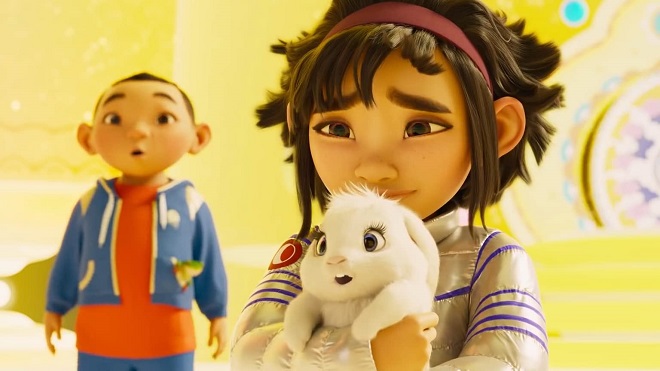
Out of everything that Over the Moon could’ve been, I was not expecting it to be a Disney style musical. That’s not a bad thing, as long as the songs and story work well together. In this case, I believe they do. Over the Moon is about a girl named Fei Fei who loses her mother, whom she loved very much, and who is worried that her father is going to forget the love he had for his wife, so in order to prevent his marriage to a new woman, Fei Fei journeys to the moon with her pet rabbit and a couple stowaways to meet the moon goddess who lives there in order to bring back proof that love lasts forever and should never be replaced.
The moon goddess is Chang’e, who lost her lover many years ago and has been waiting for his return, but time is getting short to bring him back. Fei Fei believes that if she brings back a photo of her with Chang’e, it’ll remind her father of the good times he had with her mother and will prevent the wedding from going forward. Chang’e believes that Fei Fei was supposed to bring a gift with her to the moon that would aid in the magic required to reunite her with her own dead lover, Houyi, so she acts as a villain of sorts, withholding the photo evidence until she receives the gift and can bring Houyi back.
The story feels very much like an anime designed by a Western studio, taking aspects of Chinese mythology and weaving in a suspension of disbelief that allows for the audience to accept the idea that a young girl in grade school can turn knowledge of magnetic levitation trains into a rocket ship that could take her to the stars. There’s even a rabbit to be found on the moon! Not as many as in Final Fantasy XIV: Endwalker, of course, and when it comes to moon raves, Over the Moon did it before Yoshi-P did. That said, there’s certainly room for both in the suddenly emerging genre of fantasy adventures on the moon with people who can somehow breathe in space (Fei Fei and her fellow passengers on the trip to the moon do it with foo dog magic).
When I say Chang’e acts like a villain, it’s more like she gets in the way of what Fei Fei wants, but Chang’e herself is sympathetic and it feels like there isn’t really an antagonist in the movie at all. The biggest conflict is between Fei Fei and her own feelings regarding her soon-to-be stepmother. The trip to the moon gives her unexpected perspective and I can’t help but wonder how she explained to her father where Bungee was at the end.
I would say that if you’re a fan of movies like Moana and Encanto, both of which shied away from having villains and were instead ultimately about self discovery and provided a more introspective story, then you’ll enjoy Over the Moon. Not every adventure needs a villain, and I’m glad to see more animated films taking note of this.
Child of Kamiari Month (2021)
Rabbits?: Shiro, the white rabbit of Inaba
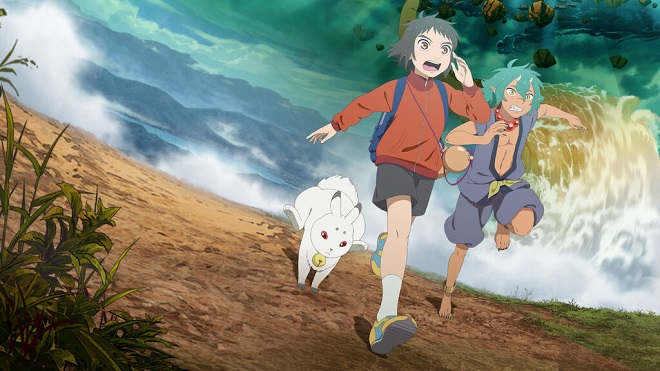
We go this week from one tale of an Asian girl with a rabbit for a companion who loses her mother early on and then finds herself on a quest to another Asian girl with a rabbit for a companion who loses her mother early on and then finds herself on a quest. Child of Kamiari Month might not go to the moon, but it’s no less a fantastical journey.
Kanna is a runner who is losing her enthusiasm for the sport after the death of her mother. When she accidentally activates the powers of her mother’s bracelet, she discovers that she’s the next Idaten, who must gather offerings for a coming feast of the gods held annually in Izumo. Along the way, she meets a demon who wants to steal the title of Idaten from her and who knew her mother. She is also led to believe that she’ll see her mother again at the end of her quest.
Just like in Over the Moon, Child of Kamiari Month deals with loss and needing to accept the loss, grieve and move on. Unlike in Over the Moon, there’s no grand adventure, but as I already said, it’s no less fantastic. Instead, it’s a down to earth (get it?) and intimate story with interesting visuals, especially when time slows down for Kanna.
So you know how in Over the Moon, I said there’s not really an antagonist? The Japanese storytelling model seems to lean more towards these kinds of stories than the American model, and it really shows here. Kanna must overcome herself in order to defeat everything that’s holding her back in her journey to fulfill the role of Idaten. The demon becomes more of a friend to Kanna than an adversary and even does his part to help when all seems lost. I feel like there are a lot of similarities between the two movies, even if their stories are different. Ultimately, neither Fei Fei nor Kanna get what they thought they wanted, but they do get what they needed.
Chickenhare and the Hamster of Darkness (2022)
Rabbits?: Chickenhare, various other characters
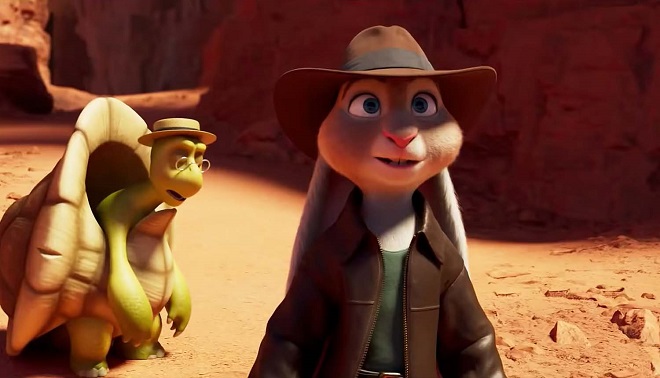
I’ve saved the best for last this week, and considering the high quality of everything I’ve watched this week, that’s saying something. Also, with a title like Chickenhare and the Hamster of Darkness, I can understand why you might hesitate. But honestly? This is such a perfect film to tide you over until the new Indiana Jones movie comes out this summer. From the score that’s reminiscent at times of John Williams’ iconic themes to an adventure that doesn’t waste time and charges full speed ahead, this film has the best of every adventure movie I’ve ever enjoyed.
I do question at times the notion that the only name they could come up with for someone who is part chicken and part hare is basically literally that. I guess as long as you’re the only one, like Tigger in Winnie the Pooh, you can be named after your body.
The plot revolves around the most famous undiscovered artifact in the world, which puts it on even footing with Raiders of the Lost Ark, and which gives me a faint hope that maybe there’ll be more Chickenhare movies in the future, since a fifth Indiana Jones movie is imminent, but the long road it took to get this movie out, coupled with the fact that a limited theatre run didn’t make back its budget, feels like bad news for a potential franchise.
Still, what we do have is gold. I especially like Meg, who in the movie has been reimagined as a skunk. She’s a brilliant companion and is quite a skilled adventurer herself. In fact, at times she shows herself to be more capable than Chickenhare, but that’s more due to Chickenhare being uncomfortable in his own body and not because of any “woke agenda” that conservatives love complaining about. When Chickenhare learns to accept himself, he and Meg are nearly unstoppable. Along for the ride is Chickenhare’s long time friend Abe, a tortoise who isn’t annoying despite how often he worries for his own safety.
The villain of the movie is also pretty effective. Lapin doesn’t fall into the trap of being written like a buffoon in order to give the heroes a free ride through the story. In fact, there’s a moment in the film where it almost seems like he does act pretty buffoonish, only to reveal that he was manipulating the heroes all along. Although he’s not written with the same subtlety as Scar from The Lion King or Jafar from Aladdin, there’s something refreshing about a good villain in a modern animated movie, and not one of those fake out villains that have become very popular lately. Lapin is an Indiana Jones style villain, and I’m very thankful for that.
It’s pretty clear that Chickenhare tried to stay as close to the original intent of the source material as possible. Instead of being a toned down, dumbly written movie for children, I would be willing to place it next to awesome adventure fare such as the Indiana Jones movies I keep mentioning, or Jungle Cruise, Treasure Planet and The Chronicles of Narnia: The Lion, The Witch and the Wardrobe.
This Week’s Short Film:
The Lady or the Tiger (1942)
Tigers?: Depends on what you choose
It would be nice if the so-called richest country in the world could afford to provide its citizens with universal healthcare to avoid the vaccine nonsense, alongside other matters. But that dream continues to slip away over time. Folks, until next week.





